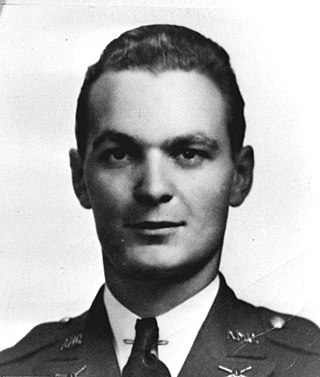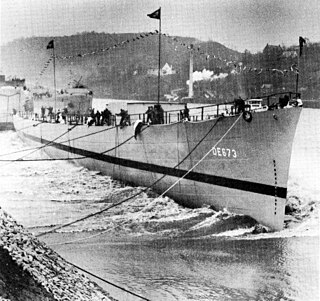
USS Hornet (CV-8), the seventh U.S. Navy vessel of that name, was a Yorktown-class aircraft carrier of the United States Navy.

Ensign George Henry Gay Jr. was a Douglas TBD Devastator pilot in United States Navy Torpedo Squadron 8 operating from the aircraft carrier USS Hornet in the Pacific Theater of Operations during World War II. Of the 30 VT-8 aircrew from Hornet that participated in the pivotal Battle of Midway, Ensign Gay was the sole survivor.

The Yorktown class was a class of three aircraft carriers built for the United States Navy and completed shortly before World War II, the Yorktown (CV-5), Enterprise (CV-6), and Hornet (CV-8). They immediately followed Ranger, the first U.S. aircraft carrier built as such, and benefited in design from experience with Ranger and the earlier Lexington class, which were conversions into carriers of two battlecruisers that were to be scrapped to comply with the Washington Naval Treaty, an arms limitation accord.

USS Harold J. Ellison (DD-864) was a Gearing-class destroyer in service with the United States Navy from 1945 to 1983. She was then transferred to Pakistan and renamed Shah Jahan (D-164). The ship was finally sunk as a target in 1994.

Torpedo Squadron 8 (VT-8) was a United States Navy squadron of World War II torpedo bombers. VT-8 was assigned initially to the air group of the aircraft carrier USS Hornet, joining the ship shortly after her commissioning in October 1941.

USS Massey (DD-778), an Allen M. Sumner-class destroyer, was a United States Navy ship that served between 1944 and 1973.

USS Robert K. Huntington (DD-781), an Allen M. Sumner-class destroyer, is the only ship of the United States Navy to be named for Robert Kingsbury Huntington, a naval aviator and member of Torpedo Squadron 8. The entire squadron was lost during the Battle of Midway.

USS Hissem (DE-400/DER-400) was an Edsall class destroyer escort of the United States Navy. Hissem was constructed in 1943 as DE-400. In 1955, the vessel was equipped with modern radars, and the designation was changed to DER-400. The special purpose of DER ships was the detection of aircraft. Their chief role was to extend the DEW line out into the N. Atlantic and the N. Pacific oceans.

USS Bebas (DE-10) was an Evarts-class destroyer escort in the service of the United States Navy from 1943 to 1945.

USS Roche (DE-197) was a Cannon-class destroyer escort in service United States Navy from 1944 to 1945. She hit a mine in late September 1945. As it was uneconomical to repair her, she was scuttled in March 1946.

USS Thornhill (DE-195) was a Cannon-class destroyer escort in service with the United States Navy from 1943 to 1947. In 1951, the ship was transferred to the Italian Marina Militare and renamed Aldebaran. The ship remained in service until 1976 when she was sold for scrap.

USS Strickland (DE-333) was an Edsall-class destroyer escort in service with the United States Navy from 1944 to 1946 and from 1952 to 1959. She was sold for scrapping in 1974.

USS Janssen (DE-396) was an Edsall-class destroyer escort in service with the United States Navy from 1943 to 1946. She was sold for scrapping in 1973.

USS Woodson (DE-359) was a John C. Butler-class destroyer escort acquired by the United States Navy during World War II. The primary purpose of the destroyer escort was to escort and protect ships in convoy, in addition to other tasks as assigned, such as patrol or radar picket.

USS Haas (DE-424) was a John C. Butler-class destroyer escort acquired by the U.S. Navy during World War II. The primary purpose of the destroyer escort was to escort and protect ships in convoy, in addition to other tasks as assigned, such as patrol or radar picket.

USS Oswald A. Powers (DE-542) was a United States Navy John C. Butler-class destroyer escort launched during World War II but never completed.

USS Fieberling (DE-640) was a Buckley-class destroyer escort in service with the United States Navy from 1944 to 1948. She sold for scrap in 1972.

USS Jack W. Wilke (DE-800) was a Buckley-class destroyer escort of the United States Navy.
George M. Campbell was a United States Navy officer. He was killed in action at the Battle of Midway while flying a torpedo bomber during an attack against several Japanese aircraft carriers.

USS John P. Gray (APD-74), ex-DE-673, was a United States Navy high-speed transport in commission from 1944 to 1946.



















